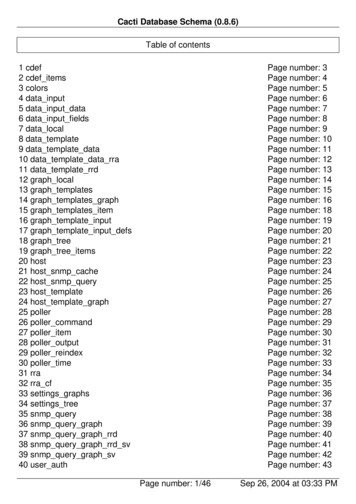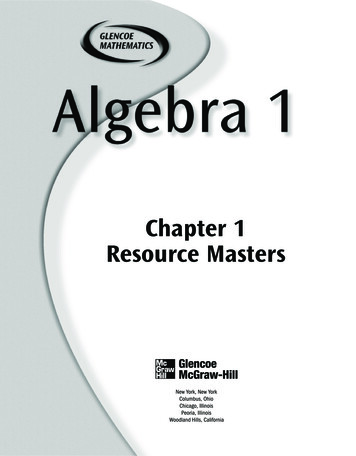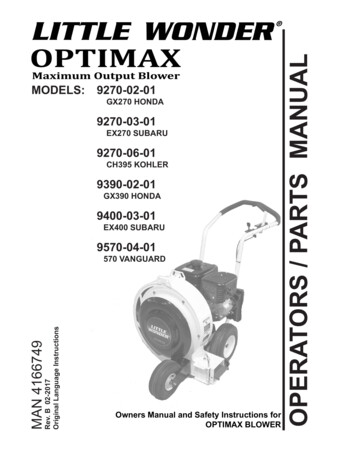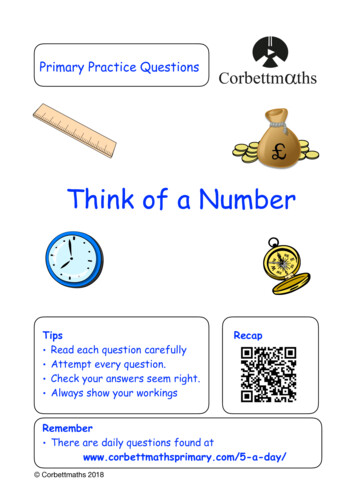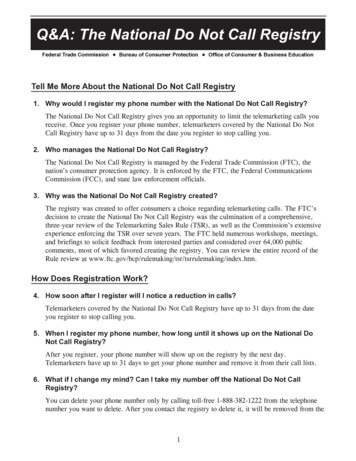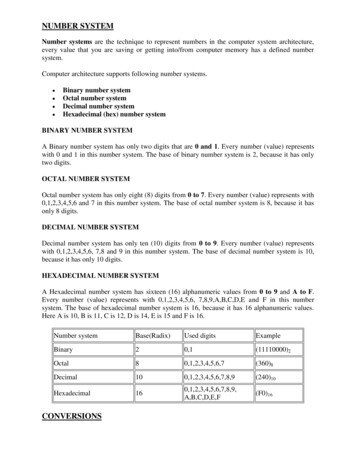
Transcription
NUMBER SYSTEMNumber systems are the technique to represent numbers in the computer system architecture,every value that you are saving or getting into/from computer memory has a defined numbersystem.Computer architecture supports following number systems. Binary number systemOctal number systemDecimal number systemHexadecimal (hex) number systemBINARY NUMBER SYSTEMA Binary number system has only two digits that are 0 and 1. Every number (value) representswith 0 and 1 in this number system. The base of binary number system is 2, because it has onlytwo digits.OCTAL NUMBER SYSTEMOctal number system has only eight (8) digits from 0 to 7. Every number (value) represents with0,1,2,3,4,5,6 and 7 in this number system. The base of octal number system is 8, because it hasonly 8 digits.DECIMAL NUMBER SYSTEMDecimal number system has only ten (10) digits from 0 to 9. Every number (value) representswith 0,1,2,3,4,5,6, 7,8 and 9 in this number system. The base of decimal number system is 10,because it has only 10 digits.HEXADECIMAL NUMBER SYSTEMA Hexadecimal number system has sixteen (16) alphanumeric values from 0 to 9 and A to F.Every number (value) represents with 0,1,2,3,4,5,6, 7,8,9,A,B,C,D,E and F in this numbersystem. The base of hexadecimal number system is 16, because it has 16 alphanumeric values.Here A is 10, B is 11, C is 12, D is 14, E is 15 and F is 16.Number systemBase(Radix)Used ERSIONS
DECIMAL TO OTHER1. DECIMAL TO BINARYDecimal Number System to Other BaseTo convert Number system from Decimal Number System to Any Other Base is quite easy;you have to follow just two steps:A) Divide the Number (Decimal Number) by the base of target base system (in which you wantto convert the number: Binary (2), octal (8) and Hexadecimal (16)).B) Write the remainder from step 1 as a Least Signification Bit (LSB) to Step last as a MostSignificant Bit (MSB).Decimal to Binary ConversionDecimal Number is : (12345)10ResultBinary Number is(11000000111001)22. DECIMAL TO OCTALDecimal to Octal Conversion ResultDecimal Number is : (12345)10Octal Number is(30071)83. DECIMAL TO HEXADECIMAL
Decimal to Hexadecimal ConversionExample 1Decimal Number is : (12345)10ResultHexadecimal Number is(3039)16Example 2Decimal Number is : (725)10Hexadecimal Number is(2D5)16Convert10, 11, 12, 13, 14, 15to its equivalent.A, B, C, D, E, FBINARY TO OTHERA) Multiply the digit with 2(with place value exponent). Eventually add all the multiplicationbecomes the Decimal number.1. BINARY TO DECIMAL2. BINARY TO OCTALAn easy way to convert from binary to octal is to group binary digits into sets of three, startingwith the least significant (rightmost) digits.Binary: 11100101 11 100 101011 100 101 Pad the most significant digits with zeros ifnecessary to complete a group of three.Then, look up each group in a table:Binary:000001010011100101110111
Octal:01234567Binary 011 100 101Octal 3 4 5 345 oct3. BINARY TO HEXADECIMALAn equally easy way to convert from binary to hexadecimal is to group binary digits into sets offour, starting with the least significant (rightmost) digits.Binary: 11100101 11100101Then, look up each group in a table:Binary:0000 0001 0010 0011 0100 0101 0110 0111Hexadecimal:01234567Binary:1000 1001 1010 1011 1100 1101 1110 1111Hexadecimal: 89ABCDEFBinary 1110 0101Hexadecimal E5 E5 hexOCTAL TO OTHER1. OCTAL TO BINARYConverting from octal to binary is as easy as converting from binary to octal. Simply look upeach octal digit to obtain the equivalent group of three binary digits.Octal: 0 1 2 3 4 5 6 7Binary: 000 001 010 011 100 101 110 111Octal 3 4 5Binary 011 100 101 011100101 binary2. OCTAL TO HEXADECIMALWhen converting from octal to hexadecimal, it is often easier to first convert the octal numberinto binary and then from binary into hexadecimal. For example, to convert 345 octal into hex:(from the previous example)Octal 345Binary 011 100 101 011100101 binary
Drop any leading zeros or pad with leading zeros to get groups of four binary digits (bits):Binary 011100101 1110 0101Then, look up the groups in a table to convert to hexadecimal digits.Binary:0000 0001 0010 0011 0100 0101 0110 0111Hexadecimal: 0Binary:12345671000 1001 1010 1011 1100 1101 1110 1111Hexadecimal: 8Binary Hexadecimal 9ABCDEF1110 0101E5 E5 hexTherefore, through a two-step conversion process, octal 345 equals binary 011100101 equalshexadecimal E5.3. OCTAL TO DECIMALThe conversion can also be performed in the conventional mathematical way, by showing eachdigit place as an increasing power of 8.345 octal (3 * 82) (4 * 81) (5 * 80) (3 * 64) (4 * 8) (5 * 1) 229 decimalORConverting octal to decimal can be done with repeated division.1.2.3.4.5.Start the decimal result at 0.Remove the most significant octal digit (leftmost) and add it to the result.If all octal digits have been removed, you’re done. Stop.Otherwise, multiply the result by 8.Go to step 2.Octal Digits Operation Decimal Result Operation Decimal Result345 33 82445 428 82245 5229done.
(345)8 (229)10HEXADECIMAL TO OTHER1. HEXADECIMAL TO BINARYConverting from hexadecimal to binary is as easy as converting from binary to hexadecimal.Simply look up each hexadecimal digit to obtain the equivalent group of four binary digits.Hexadecimal: 01234567Binary:0000 0001 0010 0011 0100 0101 0110 0111Hexadecimal: 89ABCDEFBinary:1000 1001 1010 1011 1100 1101 1110 1111Hexadecimal A2DEBinary 1010 0010 1101 1110 1010001011011110 binary2. HEXADECIMAL TO OCTAL
1's complementThe 1's complement of a number is found by changing all 1's to 0's and all 0's to 1's. This iscalled as taking complement or 1's complement. Example of 1's Complement is as follows.Binary AdditionIt is a key for binary subtraction, multiplication, division. There are four rules of binary addition.
In fourth case, a binary addition is creating a sum of (1 1 10) i.e. 0 is written in the givencolumn and a carry of 1 over to the next column.Example Addition2's complementThe 2's complement of binary number is obtained by adding 1 to the Least Significant Bit (LSB)of 1's complement of the number.2's complement 1's complement 1Example of 2's Complement is as follows.
Rules of Binary Addition 0011 0101 0110,and carry 1 to the next more significant bitFor example,00011010 00001100 001001100 00010011011011000Carries 26(base 10) 12(base 10)00100110 38(base 10)0 01001011111011011110carries 19(base 10) 62(base 10)01010001 81(base 10)00010011 00111110 01010001Rules of Binary Multiplication 0011xxxx0101 0001,and no carry or borrow bitsFor example,00101001 00000110 111101100 0001000100101100100010100000010100010000011110110 41(base 10)6(base 10) 246(base 10)Binary DivisionBinary division is the repeated process of subtraction, just as in decimal division.For example,00101010 00000110 111 7(base 10)
00000111110)0011010110-10 1101--42(base 10)6(base 10)borrows10110111100010000111 00000101 00011011101)1--11011 00111 1001011110135(base10) 1011101110111100---110Example Division27(base 10)5(base 10)
HTMLTags are containers. The html tag indicates that everything between html and /html is codethat conforms to the standards of the type of HTML. Everything between the opening tag andclosing tag are inside that tag and therefore have the attributes that tag gives them. Thoseattributes can be modified.SR.NO1.TAGNAME HEAD ATTRIBUTESDESCRIPTIONThefollowingelementscan goinsidethe head element:The head element is a container forall the head elements.EXAMPLE !DOCTYPE html html head The head element can include a title title Title of the document /title for the document, scripts, styles, meta /head body information, and more.The content of the document. /body /html title 2. A hreftarget blankThe a tag defines a hyperlink,which is used to link from one page toanother.parentThe most important attribute of the a element is the href attribute,which indicates the link's destination.selftop3. P alignThe p tag defines a paragraph.4. FONT colorfacesizeThe font tag specifies the font face,font size, and color of text.5. H1 H6 alignThe h1 to h6 tags are used todefine HTML headings. h1 defines the most importantheading. h6 defines the leastimportant heading. !DOCTYPE html html head title Title of the document /title /head body a href "http://www.yahoo.com" Visityahoo.com! /a /body /html !DOCTYPE html html head title Title of the document /title /head body p This is some text in a paragraph. /p /body /html html head title Title of the document /title /head body font size "3" color "red" This issome text! /font font size "2" color "blue" This is sometext! /font font face "verdana" color "green" This issome text! /font /body /html html head title Title of the document /title /head body h1 This is heading 1 /h1 h2 This is heading 2 /h2 h3 This is heading 3 /h3
6. TABLE alignbgcolorbordercellpaddingcellspacingwidth7. UL compacttype8. IMG 9. HR 0. VIDEO autoplayheightloopsrcwidthcontrols11. LINK hrefreltype h4 This is heading 4 /h4 h5 This is heading 5 /h5 h6 This is heading 6 /h6 /body /html The table tag defines an HTML html table. head title Title of the document /title /head body An HTML table consists of the table element and one or more tr , table tr th , and td elements. th Month /th th Savings /th The tr element defines a table row, /tr the th element defines a table tr header, and the td element defines a td January /td table cell. td 100 /td /tr /table /body /html The ul tag defines an unordered html head title Title of the(bulleted) list.document /title /head body ul li Coffee /li Use the ul tag together with the li li Tea /li li Milk /li /ul /body /html tag to create unordered lists.The img tag defines an image in an html HTML page. head title Title of the document /title /head body img src "smiley.gif" alt "SmileyThe img tag has two requiredface" height "42" width "42" /body attributes: src and alt. /html The hr tag defines a thematic break h1 HTML /h1 in an HTML page (e.g. a shift of p HTML is a language for describing webtopic).pages. /p hr h1 CSS /h1 The hr element is used to separate p CSS defines how to display HTMLcontent (or define a change) in anelements. /p HTML page.The video tag specifies video, such html as a movie clip or other video streams. head title Title of the document /title /head Currently, there are 3 supported video body video width "320" height "240"controls source src "movie.mp4"formats for the video element:type "video/mp4" MP4, WebM, and Ogg. source src "movie.ogg"type "video/ogg" Your browser does not support the videotag. /video /body /html The link tag defines a link between head a document and an external link rel "stylesheet" type "text/css"resource.The link tag is used to link href "theme.css" to external style sheets. /head
XMLXML stands for Extensible Markup Language and is a text-based markup language derivedfrom Standard Generalized Markup Language (SGML).XML tags identify the data and are used to store and organize the data, rather than specifyinghow to display it like HTML tags, which are used to display the data. XML is not going toreplace HTML in the near future, but it introduces new possibilities by adopting manysuccessful features of HTML.There are three important characteristics of XML that make it useful in a variety of systems andsolutions: XML is extensible: XML allows you to create your own self-descriptive tags, orlanguage, that suits your application. XML carries the data, does not present it: XML allows you to store the datairrespective of how it will be presented. XML is a public standard: XML was developed by an organization called the WorldWide Web Consortium (W3C) and is available as an open standard.XML UsageA short list of XML usage says it all: XML can work behind the scene to simplify the creation of HTML documents for largeweb sites. XML can be used to exchange the information between organizations and systems. XML can be used for offloading and reloading of databases. XML can be used to store and arrange the data, which can customize your data handlingneeds. XML can easily be merged with style sheets to create almost any desired output. Virtually, any type of data can be expressed as an XML document.XML is a markup language that defines set of rules for encoding documents in a format that isboth human-readable and machine-readable. So what exactly is a markup language? Markup isinformation added to a document that enhances its meaning in certain ways, in that it identifiesthe parts and how they relate to each other. More specifically, a markup language is a set ofsymbols that can be placed in the text of a document to demarcate and label the parts of thatdocument.Following example shows how XML markup looks, when embedded in a piece of text: message text Hello, world! /text /message
This snippet includes the markup symbols, or the tags such as message . /message and text . /text . The tags message and /message mark the start and the end of the XMLcode fragment. The tags text and /text surround the text Hello, world!.Example: ?xml version "1.0"? contact-info name Tanmay Patil /name company TutorialsPoint /company phone (011) 123-4567 /phone /contact-info The following diagram depicts the syntax rules to write different types of markup and text in anXML document.Each component of the above diagram in detail:XML DeclarationThe XML document can optionally have an XML declaration. It is written as below: ?xml version "1.0" encoding "UTF-8"? Where version is the XML version and encoding specifies the character encoding used in thedocument.Syntax Rules for XML declaration The XML declaration is case sensitive and must begin with " ?xml " where "xml" iswritten in lower-case. If document contains XML declaration, then it strictly needs to be the first statement ofthe XML document. The XML declaration strictly needs be the first statement in the XML document.
An HTTP protocol can override the value of encoding that you put in the XMLdeclaration.Tags and ElementsAn XML file is structured by several XML-elements, also called XML-nodes or XML-tags.XML-elements' names are enclosed by triangular brackets as shown below: element Syntax Rules for Tags and ElementsElement Syntax: Each XML-element needs to be closed either with start or with end elementsas shown below: element . /element or in simple-cases, just this way: element/
CSSCascading Style Sheets, fondly referred to as CSS, is a simple design language intended tosimplify the process of making web pages presentable.CSS handles the look and feel part of a web page. Using CSS, you can control the color of thetext, the style of fonts, the spacing between paragraphs, how columns are sized and laid out,what background images or colors are used, layout designs,variations in display for differentdevices and screen sizes as well as a variety of other effects.CSS is easy to learn and understand but it provides powerful control over the presentation of anHTML document. Most commonly, CSS is combined with the markup languages HTML orXHTML.Advantages of CSS CSS saves time You can write CSS once and then reuse same sheet in multiple HTMLpages. You can define a style for each HTML element and apply it to as many Webpages as you want. Pages load faster If you are using CSS, you do not need to write HTML tag attributesevery time. Just write one CSS rule of a tag and apply it to all the occurrences of thattag. So less code means faster download times. Easy maintenance To make a global change, simply change the style, and all elementsin all the web pages will be updated automatically. Superior styles to HTML CSS has a much wider array of attributes than HTML, soyou can give a far better look to your HTML page in comparison to HTML attributes. Multiple Device Compatibility Style sheets allow content to be optimized for morethan one type of device. By using the same HTML document, different versions of awebsite can be presented for handheld devices such as PDAs and cell phones or forprinting. Global web standards Now HTML attributes are being deprecated and it is beingrecommended to use CSS. So its a good idea to start using CSS in all the HTML pagesto make them compatible to future browsers. Offline Browsing CSS can store web applications locally with the help of an offlinecatche.Using of this, we can view offline websites.The cache also ensures faster loadingand better overall performance of the website.
Platform Independence The Script offer consistent platform independence and cansupport latest browsers as well.A CSS comprises of style rules that are interpreted by the browser and then applied to thecorresponding elements in your document. A style rule is made of three parts Selector A selector is an HTML tag at which a style will be applied. This could be anytag like h1 or table etc. Property - A property is a type of attribute of HTML tag. Put simply, all the HTMLattributes are converted into CSS properties. They could be color, border etc. Value - Values are assigned to properties. For example, color property can have valueeither red or #F1F1F1 etc.You can put CSS Style Rule Syntax as follows selector { property: value }Example: You can define a table border as follows table{ border :1px solid #C00; }Here table is a selector and border is a property and given value 1px solid #C00 is the value ofthat property.You can define selectors in various simple ways based on your comfort. Let me put theseselectors one by one.The Type SelectorsThis is the same selector we have seen above. Again, one more example to give a color to alllevel 1 headings:h1 {color: #36CFFF;}The Universal Selectors
Rather than selecting elements of a specific type, the universal selector quite simply matches thename of any element type *{color: #000000;}This rule renders the content of every element in our document in black.The Descendant SelectorsSuppose you want to apply a style rule to a particular element only when it lies inside aparticular element. As given in the following example, style rule will apply to em elementonly when it lies inside ul tag.ul em {color: #000000;}The Class SelectorsYou can define style rules based on the class attribute of the elements. All the elements havingthat class will be formatted according to the defined rule.black {color: #000000;}This rule renders the content in black for every element with class attribute set to black in ourdocument. You can make it a bit more particular. For example:h1.black {color: #000000;}This rule renders the content in black for only h1 elements with class attribute set to black.You can apply more than one class selectors to given element. Consider the following example: p class "center bold" This para will be styled by the classes center and bold. /p
The ID SelectorsYou can define style rules based on the id attribute of the elements. All the elements havingthat id will be formatted according to the defined rule.#black {color: #000000;}This rule renders the content in black for every element with id attribute set to black in ourdocument. You can make it a bit more particular. For example h1#black {color: #000000;}This rule renders the content in black for only h1 elements with id attribute set to black.The true power of id selectors is when they are used as the foundation for descendant selectors,For example:#black h2 {color: #000000;}In this example all level 2 headings will be displayed in black color when those headings willlie with in tags having id attribute set to black.Example: !DOCTYPE html html head style type "text/css" media "all" body {background-color: linen;}h1 {color: maroon;margin-left: 40px;
} /style /head body h1 This is a heading /h1 p This is a paragraph. /p /body /html Inline CSS - The style AttributeYou can use style attribute of any HTML element to define style rules. These rules will beapplied to that element only. Here is the generic syntax element style ".style rules." AttributesAttributeValueDescriptionstylestyle rulesThe value of style attribute is a combination of style declarationsseparated by semicolon (;).ExampleFollowing is the example of inline CSS based on the above syntax html head /head body h1 style "color:#36C;" This is inline CSS /h1 /body /html
External CSS - The link ElementThe link element can be used to include an external stylesheet file in your HTML document.An external style sheet is a separate text file with .css extension. You define all the Style ruleswithin this text file and then you can include this file in any HTML document using link element.Here is the generic syntax of including external CSS file head link type "text/css" href "." media "." / /head ExampleConsider a simple style sheet file with a name mystyle.css having the following rules h1, h2, h3 {color: #36C;font-weight: normal;letter-spacing: .4em;margin-bottom: 1em;text-transform: lowercase;}Now you can include this file mystyle.css in any HTML document as follows head link type "text/css" href "mystyle.css" media " all" / /head WEB SERVERS
A Web server is a program that uses HTTP (Hypertext Transfer Protocol) to serve the files thatform Web pages to users, in response to their requests, which are forwarded by their computers'HTTP clients. Dedicated computers and appliances may be referred to as Web servers as well.The process is an example of the client/server model. All computers that host Web sites musthave Web server programs. Leading Web servers include Apache (the most widely-installedWeb server), Microsoft's Internet Information Server (IIS) and nginx (pronouncedengine X) fromNGNIX. Other Web servers include Novell's NetWare server, Google Web Server (GWS) andIBM's family of Domino servers.Web servers often come as part of a larger package of Internet- and intranet-related programs forserving email, downloading requests for File Transfer Protocol (FTP) files, and building andpublishing Web pages. Considerations in choosing a Web server include how well it works withthe operating system and other servers, its ability to handle server-side programming, securitycharacteristics, and the particular publishing, search engine and site building tools that comewith it.There are four leading web servers Apache, IIS, lighttpd and Jagsaw. Apart from these WebServers, there are other Web Servers also available in the market but they are very expensive.Major ones are Netscape's iPlanet, Bea's Web Logic and IBM's WebSphere.Apache HTTP ServerThis is the most popular web server in the world developed by the Apache SoftwareFoundation. Apache web server is an open source software and can be installed on almost alloperating systems including Linux, Unix, Windows, FreeBSD, Mac OS X and more. About60% of the web server machines run the Apache Web Server.Internet Information ServicesThe Internet Information Server (IIS) is a high performance Web Server from Microsoft. Thisweb server runs on Windows NT/2000 and 2003 platforms ( and may be on upcoming newWindows version also). IIS comes bundled with Windows NT/2000 and 2003; Because IIS istightly integrated with the operating system so it is relatively easy to administer it.lighttpdThe lighttpd, pronounced lighty is also a free web server that is distributed with the FreeBSDoperating system. This open source web server is fast, secure and consumes much less CPUpower. Lighttpd can also run on Windows, Mac OS X, Linux and Solaris operating systems.Sun Java System Web ServerThis web server from Sun Microsystems is suited for medium and large websites. Though theserver is free it is not open source. It however, runs on Windows, Linux and Unix platforms.
The Sun Java System web server supports various languages, scripts and technologies requiredfor Web 2.0 such as JSP, Java Servlets, PHP, Perl, Python, Ruby on Rails, ASP and Coldfusionetc.Jigsaw ServerJigsaw (W3C's Server) comes from the World Wide Web Consortium. It is open source and freeand can run on various platforms like Linux, Unix, Windows, Mac OS X Free BSD etc. Jigsawhas been written in Java and can run CGI scripts and PHP programs.DATABASEA database is a separate application that stores a collection of data. Each database has one ormore distinct APIs for creating, accessing, managing, searching and replicating the data it holds.Other kinds of data stores can be used, such as files on the file system or large hash tables inmemory but data fetching and writing would not be so fast and easy with those types ofsystems.So nowadays, we use relational database management systems (RDBMS) to store and managehuge volume of data. This is called relational database because all the data is stored intodifferent tables and relations are established using primary keys or other keys known as foreignkeys.A Relational DataBase Management System (RDBMS) is a software that: Enables you to implement a database with tables, columns and indexes. Guarantees the Referential Integrity between rows of various tables. Updates the indexes automatically. Interprets an SQL query and combines information from various tables.RDBMS TERMINOLOGY:Before we proceed to explain MySQL database system, let's revise few definitions related todatabase. Database: A database is a collection of tables, with related data. Table: A table is a matrix with data. A table in a database looks like a simplespreadsheet.
Column: One column (data element) contains data of one and the same kind, forexample the column postcode. Row: A row ( tuple, entry or record) is a group of related data, for example the data ofone subscription. Redundancy: Storing data twice, redundantly to make the system faster. Primary Key: A primary key is unique. A key value can not occur twice in one table.With a key, you can find at most one row. Foreign Key: A foreign key is the linking pin between two tables. Compound Key: A compound key (composite key) is a key that consists of multiplecolumns, because one column is not sufficiently unique. Index: An index in a database resembles an index at the back of a book. Referential Integrity: Referential Integrity makes sure that a foreign key value alwayspoints to an existing row.MS ACCESSMicrosoft Access is a unique tool released by Microsoft that provides both the functionality of adatabase and the programming capabilities to create end-user screens. Each version of Accesscan "look and feel" completely different from another.Microsoft Access stores information in what is called a database. Microsoft Access isan information management tool that helps you store information for reference, reporting, andanalysis. Microsoft Access helps you analyze large amounts of information, and manage relateddata more efficiently than Microsoft Excel or other spreadsheet applications.There are four major steps to using Microsoft Access:1. Database Creation: Create your Microsoft Access database and specify what kind ofdata you will be storing. A retail business might create a database to store all their salesinformation (i.e. items sold, customer, employee, commission, etc)2. Data Input: After your database is created the data the store gathers every business daycan be entered into the Access database.3. Query: This is a fancy term to basically describe the process of retrieving informationfrom the database.4. Report(optional): Information from the database is organized in a nice presentation thatcan be printed in an Access Report.
CREATING ACCESS DATABASETo create a new database in Access follow these steps:1. Start Access2. From the menu choose File New3. The "New File" side bar will be displayed on the right-hand side of the screen4. Left-click the option "Blank database.", which will then ask you to name your database.Helpful Hint: Access databases are saved with the .mdb extension.5. Name your file (we chose TizagDB) and press Create. This will automatically save yourblank database, so remember where you put it!6. The Access Database interface should now be displayed and you are well on your way tolearning Access!Now that the database has been created we can begin to create our first Access Table. A tableresides within a database and holds information specific to a certain area.
ACCESS FORMSAccess provides an easy way to enter data into your Access tables with forms. In Access youhave the ability to quickly make and customize these data entry forms to streamline the datainput process.CREATING AN ACCESS FORMAlthough we haven't recommended the various wizards that Access had available in theprevious lessons, the form wizard is actually very useful and should save you a bunch of time!Let's create a simple data input form for the new employee!1. Navigate to the Forms section in Access2. Double-click "Create form by using wizard"3. We want all of the fields from tbl Sales to be included in this form, so firstselect tbl Sales fromthedropdownbox"Tables/Queries"4. The single right arrow will add one selected field at a time, but we want all the fields. Theshortcut to add every field from a given table or query is to click the double arrow button.Do that and click Next.
5. Choose a Columnar layout and press Next6. Choose any style and press Next (we chose "Sumi Painting")7. Change the form's title to frm EmployeeEntryand click FinishOpen up your form and check it out!
ENTERING DATA USING ACCESS FORMS1. Open up frm EmployeeEntry (easy!)2. At the bottom of the form is a set of arrows to navigate through the records.
DECIMAL TO OTHER 1. DECIMAL TO BINARY Decimal Number System to Other Base To convert Number system from Decimal Number System to Any Other Base is quite easy; you have to follow just two steps: A) Divide the Number (Decimal Number) by the base of target base system (in which you want to convert the number: Binary (2), octal (8) and Hexadecimal (16)).
